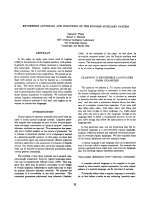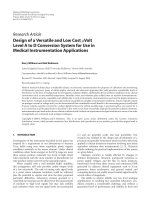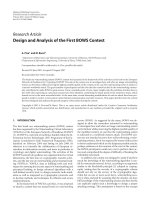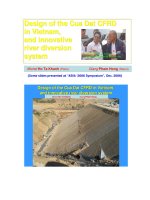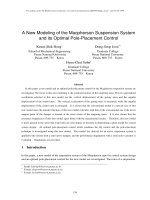RESEARCH AND DESIGN OF THE TRACTION CONTROL SYSTEM ON ELECTRIC SCOOTER
Bạn đang xem bản rút gọn của tài liệu. Xem và tải ngay bản đầy đủ của tài liệu tại đây (9.12 MB, 169 trang )
HO CHI MINH CITY UNIVERSITY OF TECHNOLOGY AND EDUCATION
FACULTY FOR HIGH QUALITY TRAINING
GRADUATION PROJECT
RESEARCH AND DESIGN OF THE TRACTION
CONTROL SYSTEM ON ELECTRIC SCOOTER
TRAN HUU MINH TIEN
Student ID: 16145051
NGUYEN NGOC VU
Student ID: 16145061
Major: AUTOMOTIVE ENGINEERING
Advisor: M.Sc. Nguyen Trung Hieu
Ho Chi Minh City, August 2020
HO CHI MINH CITY UNIVERSITY OF TECHNOLOGY AND EDUCATION
FACULTY FOR HIGH QUALITY TRAINING
GRADUATION PROJECT
RESEARCH AND DESIGN OF THE TRACTION
CONTROL SYSTEM ON ELECTRIC SCOOTER
TRAN HUU MINH TIEN
Student ID: 16145051
NGUYEN NGOC VU
Student ID: 16145061
Major: AUTOMOTIVE ENGINEERING
Advisor: M.Sc. Nguyen Trung Hieu
Ho Chi Minh City, August 2020
THE SOCIALIST REPUBLIC OF VIETNAM
Independence – Freedom – Happiness
-------Ho Chi Minh City, 12th August, 2020
GRADUATION PROJECT ASSIGNMENT
Student name: _________________________
Student
__________________________
Student ID: ___________________
name: Student ID: ___________________
Major:
________________________________
Advisor: ______________________________
Class: ________________________
Date of assignment: _____________________
Date of submission: _____________
Phone number: _________________
1. Project title: _________________________________________________________
2. Initial materials provided by the advisor: ___________________________________
3. Content of the project: _________________________________________________
4. Final product: ________________________________________________________
CHAIR OF THE PROGRAM
ADVISOR
(Sign with full name)
(Sign with full name)
THE SOCIALIST REPUBLIC OF VIETNAM
Independence – Freedom – Happiness
-------Ho Chi Minh City, 12th August, 2020
ADVISOR’S EVALUATION SHEET
Student name: .................................................................
Student ID: .................................
Student name: .................................................................
Student ID: .................................
Major: .....................................................................................................................................
Project title: ............................................................................................................................
................................................................................................................................................
Advisor: .............................................................................................................................
EVALUATION
1. Content of the project:
.................................................................................................................................................
.................................................................................................................................................
.................................................................................................................................................
2. Strengths:
.................................................................................................................................................
.................................................................................................................................................
.................................................................................................................................................
3. Weaknesses:
.................................................................................................................................................
.................................................................................................................................................
.................................................................................................................................................
4. Approval for oral defense? (Approved or denied)
.................................................................................................................................................
5. Overall evaluation: (Excellent, Good, Fair, Poor)
.................................................................................................................................................
6. Mark……………. (in words: ..............................................................................................)
Ho Chi Minh City, 12th August, 2020
ADVISOR
(Sign with full name)
THE SOCIALIST REPUBLIC OF VIETNAM
Independence – Freedom – Happiness
-------Ho Chi Minh City, 12th August, 2020
PRE-DEFENSE EVALUATION SHEET
Student name: .................................................................
Student ID: .............................
Student name: .................................................................
Student ID: .............................
Major: .....................................................................................................................................
Project title: .............................................................................................................................
.................................................................................................................................................
Name of Reviewer: .................................................................................................................
EVALUATION
1. Content and workload of the project
.................................................................................................................................................
.................................................................................................................................................
.................................................................................................................................................
2. Strengths:
.................................................................................................................................................
.................................................................................................................................................
.................................................................................................................................................
3. Weaknesses:
.................................................................................................................................................
.................................................................................................................................................
.................................................................................................................................................
4. Approval for oral defense? (Approved or denied)
.................................................................................................................................................
5. Overall evaluation: (Excellent, Good, Fair, Poor)
.................................................................................................................................................
6. Mark……………. (in words: ..............................................................................................)
Ho Chi Minh City, 12th August, 2020
REVIEWER
(Sign with full name)
THE SOCIALIST REPUBLIC OF VIETNAM
Independence – Freedom – Happiness
--------
EVALUATION SHEET OF DEFENSE COMMITTEE MEMBER
Student name: .................................................................
Student ID: .............................
Student name: .................................................................
Student ID: .............................
Major: ......................................................................................................................................
Project title: ..............................................................................................................................
..................................................................................................................................................
Name of Defense Committee
Member: ..............................................................................................................................................
.....
EVALUATION
1. Content and workload of the project
.................................................................................................................................................
.................................................................................................................................................
................................................................................................................................................
2. Strengths:
.................................................................................................................................................
.................................................................................................................................................
.................................................................................................................................................
3. Weaknesses:
.................................................................................................................................................
.................................................................................................................................................
.................................................................................................................................................
4. Overall evaluation: (Excellent, Good, Fair, Poor)
.................................................................................................................................................
5. Mark: ……………. (in words: ........................................................................................)
Ho Chi Minh City, 14th August, 2020
COMMITTEE MEMBER
(Sign with full name)
DISCLAIMER
The authors, Tran Huu Minh Tien, and Nguyen Ngoc Vu, confirm that the work presented
in this thesis is of my own.
All the data, statistics in the thesis are reliable and are not published in any previous
studies or researches. Where information has been derived from other sources, I confirm
that this has been indicated in the thesis.
Ho Chi Minh City, 12th of August, 2020
1
ACKNOWLEDGEMENT
Completing the graduation dissertation on time and successfully has been a tremendous
accomplishment for the authors along with all the supports throughout the entire working
progress.
We would like to express our sincere gratitude toward our instructor and advisor, M.Sc.
Mr. Nguyen Trung Hieu for his instant and continuous supports for our graduation
dissertation so that it could be completed in time.
We would also extend my thanks to all the University Managing Board, the Faculty of
High-Quality Training, Faculty of Vehicle and Energy Engineering and all other related
departments for facilitating our work.
Finally, we would like to thank my family for always being by our sides throughout our
course in order to make the best result out of it.
Sincere!
Ho Chi Minh City, 12th of August, 2020
Researcher
2
TABLE OF CONTENTS
DISCLAIMER
i
ACKNOWLEDGEMENT
ii
TABLE OF CONTENTS
iii
TABLE OF FIGURES
vii
LIST OF TABLES
xii
LIST OF ABBREVIATION
xiii
ABSTRACT
xiv
Chapter 1: INTRODUCTION
1
1.1.
Problem statement
1
1.2.
Proposed methods
2
1.3.
Dissertation purposes
2
1.4.
Dissertation content
2
Chapter 2: LITERATURE REVIEW
2.1.
Investigate electric motorbikes currently available:
2.1.1.
4
4
2.1.1.1. Introduction about PEGA
4
2.1.1.2. PEGA electric motorbike models
4
2.1.2.
Yadea
5
2.1.2.1. Introduction about Yadea
5
2.1.2.2. Yadea electric motorbike models
5
2.1.3.
Vinfast
7
2.1.3.1. Introduction about Vinfast
7
2.1.3.2. Vinfast electric motorbike models
7
2.1.4.
Anbico
9
2.1.4.1. Introduction about Anbico
9
2.1.4.2. Anbico electric motorbike models
9
2.1.5.
2.2.
PEGA
4
Conclusion
11
Reference science articles
12
Chapter 3: FUNDAMENTAL
16
3
3.1.
Structure of electric scooter
16
3.2.
Operation principle of electric motor in an electric motorbike
16
3.2.1.
3.3.
3.4.
Power source supply
Introduction brushless DC motor (BLDC)
16
17
3.3.1.
The construction of brushless DC motor
17
3.3.2.
Construction of rotor
18
3.3.3.
Construction of stator
19
3.3.4.
Hall sensors
21
3.3.5.
Operation principle of BLDC motor
22
Traction Control system (TCS)
23
3.4.1.
History of Traction Control system (TCS)
23
3.4.2.
Traction Control system on electric vehicle
24
3.4.3.
Analysis the slipping of wheel
24
3.5.
Ohm’s Law
26
3.6.
Calculate powertrain characteristics of electric scooter
27
3.6.1.
Determine power of electric motor and capacity of batter
27
3.6.2.
Determine parameter of electric scooter
27
3.6.3.
Determine the capacity of battery
28
Chapter 4: ELECTRIC SCOOTER SIMULATION
4.1.
Application of BIKESIM software
4.1.1.
Simulate Traction control system by using BIKESIM software
29
29
29
4.1.1.1. Introduce BIKESIM software
29
4.1.1.2. Input data
33
4.1.1.3. Setting data for the EV in BIKESIM
36
4.1.1.4. Simulate Traction Control System
40
4.1.1.5. Design controller for TCS on electric scooter
43
4.2.
Results from experiment the controller of TCS on MATLAB Simulink
46
4.3.
Comparison between electric scooter with TCS and without TCS
48
4
Chapter 5: TRACTION CONTROL SYSTEM (TCS) ON THE ELECTRIC SCOOTER
51
5.1.
Control strategies
5.1.1.
5.2.
Control methods
Control algorithm
5.2.1.
Estimate wheel speed and vehicle speed
Chapter 6: EXECUTION AND EXPERIMENT ON REAL MODEL
6.1.
6.2.
6.3.
Investigation of BLDC 2000W motor
51
53
54
56
56
6.1.1.
Yuma motor 2000W
56
6.1.2.
QS – motor 205 50H V1
57
6.1.3.
QS – motor 205 50H V2
58
6.1.4.
QS - motor 205 45H V3
59
6.1.5.
Conclusion
59
6.1.6.
Characteristics of QS – motor 205 50H V2
60
Investigation of BLDC 2000W controller
63
6.2.1.
Kelly Controller QSKBS48151E
63
6.2.2.
QS Controller QSKBS48181E
64
6.2.3.
Kelly Controller QSKBS72181E
65
6.2.4.
Votol Controller EM 100
66
6.2.5.
Conclusion
67
6.2.6.
Votol EM 100 instruction
67
6.2.6.1. Wiring diagram
67
6.2.6.2. Connect controller to motor and computer
72
6.2.6.3. Debugging software (only support win 7/10)
72
Testing BLDC motor:
79
6.3.1.
6.4.
51
Operation principle:
80
Assembling electric scooter
80
6.4.1.
Chassis and powertrain system
81
6.4.2.
Suspension system
83
5
6.4.3.
Brake system
85
6.4.4.
Power supply location
87
6.4.5.
Throttle
88
6.4.6.
Controller’s placement
88
6.5.
Design Traction Control System
89
6.6.
Set up and experience Traction Control controller
96
6.6.1.
Experience in wet condition with TCS
96
6.6.2.
Result of experience in wet road condition
97
6.6.3.
Experience in icy road condition with TCS
99
6.6.4.
Result of experience in icy road condition
99
6.6.5.
Test run in icy road condition without TCS
101
6.6.6.
Comparison between electric scooter with TCS and without TCS
102
Chapter 7: CONCLUSION AND RECOMMENDATIONS
105
7.1.
Conclusion:
105
7.2.
Recommendations:
105
REFERENCES LIST
106
APPENDICES
108
6
TABLE OF FIGURES
Figure 2.1 PEGA electric motorbike models
5
Figure 2.2 Yadea electric motorbike models
7
Figure 2.3 Vinfast electric motorbike models
9
Figure 2.4 Anbico electric motorbike models
11
Figure 2.5 Block diagram of the proposed traction control system
13
Figure 2.6 Schematic view of the overall TC problem
14
Figure 2.7 Whole block diagram
15
Figure 2.8 Block diagram of Traction Control System
15
Figure 3.1 Brushless DC motor construction
17
Figure 3.2 Basic construction of BLDC
18
Figure 3.3 Types of rotor in BLDC
18
Figure 3.4 Stator’s winding of a BLDC motor
19
Figure 3.5 Trapezoidal back EFM
20
Figure 3.6 Sinusoidal back EMF
20
Figure 3.7 Position of Hall sensor in BLDC motor
21
Figure 3.8 Diagram of power supply for the winding of the stator
22
Figure 3.9 Voltage flow through each coils diagram
23
Figure 3.10 Force affect to the wheel
25
Figure 3.11 The reference slip ratio for TCS
26
Figure 4.1 User interface of BIKESIM
30
Figure 4.2 Area for setting parameters of vehicles and operating conditions
30
Figure 4.3 Algorithm solver
31
Figure 4.4 Simulation setting section
31
Figure 4.5 Block diagram of algorithm solver
32
Figure 4.6 3D animation
33
Figure 4.7 Plotter tool in BIKESIM
33
Figure 4.8 SYM Attila Elizabeth 2010
34
7
Figure 4.9 Remove components to measure dimension
35
Figure 4.10 Chose vehicle box
36
Figure 4.11 Adjust Powertrain
36
Figure 4.12 Dimension of animation scooter
37
Figure 4.13 Parameters of driver’s body
37
Figure 4.14 Steering system's parameters
38
Figure 4.15 Setting tire’s parameters
38
Figure 4.16 Input road coefficient for the simulation process
39
Figure 4.17 Generate events and procedures for simulation process
39
Figure 4.18 Time and Output channels box
40
Figure 4.19 The vehicle code of the EV in MATLAB Simulink
40
Figure 4.20 Run control option
40
Figure 4.21 Supported simulation system on BIKESIM
41
Figure 4.22 Input and Output channels
41
Figure 4.23 Graphical block diagramming of TCS EV
42
Figure 4.24 Import parameters box
43
Figure 4.25 Input spin moment
44
Figure 4.26 Output signal
44
Figure 4.27 Slip ratio calculation
45
Figure 4.28 Controller of TCS
45
Figure 4.29 Comparison function
46
Figure 4.30 Throttle opening percentage
46
Figure 4.31 Cut off signal from throttle to make spin moment equal to five
47
Figure 4.32 Slip ratio
47
Figure 4.33 Velocity of two EV
48
Figure 4.34 Slip ratio of two electric scooters
48
Figure 4.35 Front wheel speed and rear wheel speed of the two EV
49
Figure 4.36 Steering Torque
49
Figure 4.37 Velocity of the two EV with TCS and without TCS
50
8
Figure 5.1 A block diagram of a PID controller in a feedback loop.
51
Figure 5.2 Structure of a fuzzy logic controller
52
Figure 5.3 Block diagram of the Bang – Bang controller
52
Figure 5.4 Block diagram of the Bang - Bang TCS controller
53
Figure 6.1 Yuma motor
56
Figure 6.2 QS - motor 2000W 205 50H V1
57
Figure 6.3 QS - motor 2000W 205 50H V2
58
Figure 6.4 QS - motor 205 45H V3
59
Figure 6.5 Graph of rpm according to torque
60
Figure 6.6 Graph of efficiency according to torque
60
Figure 6.7 Graph of current according to torque
61
Figure 6.8 Graph of current according to torque
61
Figure 6.9 Graph of output power according to torque
62
Figure 6.10 Graph of input power according to torque
62
Figure 6.11 2D drawing of the QS – motor 205 50H V2
63
Figure 6.12 The design of Kelly controller
63
Figure 6.13 QS Controller QSKBS48181E
64
Figure 6.14 Kelly Controller QSKBS72181E
65
Figure 6.15 Votol EM 100
66
Figure 6.16 Main function connecting diagram
68
Figure 6.17 Hall sensor connector
68
Figure 6.18 Anti-theft connector
69
Figure 6.19 Front view of the main function connector
69
Figure 6.20 Front view of the hall sensor connector
70
Figure 6.21 Front view of the anti - theft connector
71
Figure 6.22 Wiring diagram to motor and computer
72
Figure 6.23 User interface of debugging software
73
Figure 6.24 Battery option
74
Figure 6.25 Voltage protection adjust
74
9
Figure 6.26 Battery current and phase current limited adjust
75
Figure 6.27 Throttle voltage adjust interface
75
Figure 6.28 Temperature protection interface
76
Figure 6.29 Downhill electric braking assist interface
76
Figure 6.30 Motor setting interface
77
Figure 6.31 Speedometer output option
77
Figure 6.32 Moving assist and cruise control function adjust interface
77
Figure 6.33 Safety function and reverse setting interface
78
Figure 6.34 Controller status interface
78
Figure 6.35 Electric motor dynamometer
79
Figure 6.36 Swingarm for EV
81
Figure 6.37 Steel round bar screw
82
Figure 6.38 Top view of powertrain system
82
Figure 6.39 Side view of powertrain system
83
Figure 6.40 Rear suspension
84
Figure 6.41 Front suspension
84
Figure 6.42 Rear brake
85
Figure 6.43 Brake fluid tank for rear brake system
86
Figure 6.44 Front brake
86
Figure 6.45 Battery compartment
87
Figure 6.46 Electric scooter throttle
88
Figure 6.47 EV controller placement
89
Figure 6.48 Hall sensor
90
Figure 6.49 Reluctor wheel
90
Figure 6.50 Location of Hall sensor in front wheel
91
Figure 6.51 Location of Hall sensor in rear wheel
91
Figure 6.52 Distance between Hall sensor and reluctor wheel
92
Figure 6.53 Arduino UNO REV3
93
Figure 6.54 DAC module MCP4725
94
10
Figure 6.55 TCS circuit
96
Figure 6.56 Wet road condition
97
Figure 6.57 Graph of testing in wet road with TCS
98
Figure 6.58 Ice road condition
99
Figure 6.59 Graph of testing in icy road with TCS
100
Figure 6.60 Slip ratio of icy road
101
Figure 6.61 Graph of testing in icy road without TCS
102
Figure 6.62 Testing path
103
Figure 6.63 Graph of vehicle speed with TCS and w/o TCS
103
Figure 6.64 Graph of rear wheel speed with TCS and w/o TCS
104
Figure 6.65 Graph of slip ratio with TCS and w/o TCS
104
11
LIST OF TABLES
Table 2.1 PEGA electric vehicle specification table
4
Table 2.2 Yadea electric vehicle specification table
6
Table 2.3 Vinfast electric vehicle specification table
8
Table 2.4 Anbico electric vehicle specification table
10
Table 2.5 Comparison table of electric motorcycles
12
Table 4.1 Dimension after measured
35
Table 6.1 Yuma motor specification table
56
Table 6.2 QS - Motor V1 specification
57
Table 6.3 QS - Motor V2 specification
58
Table 6.4 QS - Motor V3 specification
59
Table 6.5 Properties table of Kelly controller QSKBS48151E
64
Table 6.6 Properties table of QS controller
65
Table 6.7 Properties table of Kelly controller QSKBS72181E
66
Table 6.8 Properties table of Votol EM 100
67
Table 6.9 Main function pin definition
70
Table 6.10 Hall sensor pin definition
71
Table 6.11 Anti - theft pin definition
71
Table 6.12 Battery current controller setting Range
75
12
LIST OF ABBREVIATION
TCS: Traction control system
BLDC: Brushless DC Motor
MATLAB: Matrix laboratory
WHO: World Health organization
PMSM: Permanent magnet synchronous motor
EMF: Electromotive force
ESC: Electronic stability control
UMTRI: University of Michigan Transportation Research Institute
EV: Electric vehicle
SAE: Society of automotive engineers
PID: Proportional – Integral – Derivative controller
TIC: Taylor instrumental company
ICS: Industrial control systems
IDE: Integrated development environment
RPM: Revolution per minute
EBS: Electronic brake system
GUI: Graphical user interface
FWS: Front wheel speed
RWS: Rear wheel speed
W/o: Without
13
ABSTRACT
The main objectives of this thesis are to research theoretically, simulate the 3D
models on BIKESIM simulation software and conduct reality experiment on safety system
on the electric vehicle, in this case, the electric scooter and traction control system. This is
to increase the safety on the electric vehicle as this is the future type of transportation due
to many advantages compared to conventional, or internal combustion engine vehicles:
environmental-friendly, high torque and power output, multi-terrain operation… The
authors also want to have a deep research into electric vehicle field in order to apply
anything currently available into reality, turning this research into a fundament for any
further research on the topic.
This paper was divided into 5 chapters. The first chapter was the detail introduction
about the problem statements, proposed solution for the topic, research method and the
purpose of the research. The second chapter was about the literature review by the authors
on the structure of electric scooter, brushless DC motor, related components, and physics
laws. The authors applied the MATLAB Simulink and BIKESIM to simulate the digital
electric scooter model on the simulation environment in the third chapter. The fourth
chapter was all about the traction control in the conventional vehicle and in the electric
scooter. Finally, the reality experiment was conducted and reported in the last chapter,
chapter five.
Keyword: electric scooter, traction control, electric vehicle, modeling, simulation, electric
motor, brushless motor.
14
Chapter 1: INTRODUCTION
1.1.
Problem statement
The world is witnessing a tremendous change in technology development and
industrial production thanks to the application of the achievements of the scientific and
technological revolution. At the same time, air pollution has become an urgent problem
that the world needs to solve. There are many causes to air pollution such as emissions
from industrial plants, emissions from road vehicles, waterways, and railways, etc. As a
result, it causes the greenhouse effect, global warming, and depletion of ozone. This has a
significant impact on the environment and health of all living creatures on earth, including
humans.
According to the WHO annual air pollution report that kills approximately 7 million
people worldwide each year, WHO data collected shows that for every 10 people, 9 will
breathe air containing high levels of pollutants. As reported by WHO, six main substances
causing air pollution that affect human health include: Nitrous oxide (NOx), Sulfur oxide
(Sox), Carbon monoxide (CO), Carbon dioxide (CO2), Lead, Ozone ground layer,
suspended particulate matter particles. In the face of the above situation, governments
around the world have come up with many solutions in order to cut down and overcomes
air pollution such as inspire people to use public transport, clarify exhaust from industrial
plants and vehicles, plant more tree, etc.
In the automobile industrial field to solve the issue of air pollution, manufacturers
have given a solution that is to switch to using electric motors instead of using a
conventional internal combustion engine. When an internal combustion engine working,
the product released outside the environment includes CO, CO2, NOx, HC, Pb, CFC, and
sulfur compounds. But these products are on the list of main substances that cause air
pollution. According to statistics of the Ministry of Transport of Vietnam, the number of
motorcycles in circulation in Vietnam has reached 60 million vehicles by the end of 2019
and the number of cars has reached 4 million between the end of 2016 and 2020.
Motorcycles accounted for 93.75% of all vehicles in Viet Nam. According to research
results of the Institute of Environment and Resources (National University of Ho Chi Minh
City), emissions from two wheels vehicles are the largest source of air pollution. In
particularly, motorcycles only consume about 56% of the fuel but exhaust up to 94% HC,
87% CO and 57% NOx in the total emissions of all vehicles. These data above show that
the internal combustion engine is one of the biggest causes of air pollution in the world.
Therefore, this is the first reason that car and motorbike manufacturers gradually switch to
use the electric motor to be more friendly to the environment. Besides, one of the main
drawbacks of internal combustion engines compared to electric motors is performance.
Internal combustion engines convert heat energy into mechanical energy but during the
1
converting process, the loss of power in heat energy is very large. Therefore, the efficiency
of the internal combustion engine is about 35%. For electric motors working based on the
phenomenon of electromagnetic induction, in which electrical energy will be transformed
into mechanical energy. When electric motor working, it also generates heat (heated due to
conductors’ resistance and friction), but compared to the internal combustion engine, this
temperature is negligible. Therefore, the efficiency of electric motors is approximately
90%. In addition, the electric motor achieves the maximum torque at the lowest speed and
has the motor characteristic line like the real human desire without any powertrain. This is
the second reason that car and motorbike manufacturers in the world decide to replace
conventional internal combustion engines. Thus, electric motor is becoming a trend in the
world because of its advanced features such as higher efficiency than traditional,
environmentally friendly. However, the torque characteristics of the electric motor at a
minimum speed are very high. When crossing the road surface with minimal friction or
rapid acceleration will cause a wheel skid can lead to a dangerous accident for the driver.
Therefore, in order to contribute to increasing the safety of electric motorbikes for
drivers, the team decided to select the topic "Research, simulation, and construction of
electric motorbike models with traction control using the BIKESIM and MATLAB
Simulink software" to carry out.
1.2.
Proposed methods
● Survey method: Find out information about electric motorbikes available in Vietnam
and foreign markets. Investigate the types of electric motors and control methods
used by manufacturers.
● Documents research method: find out and research science articles of the Traction
Control controller to understand the operating principle and control methods of the
controller. Read the documentation to learn how to simulate two wheels vehicle and
Traction Control by BIKESIM and MATLAB Simulink software.
● Refer to the instructor's advice.
● After the survey, research and collect all the necessary data for the topic. Simulate
on the software. After the simulation on the software, implement and build a real
model.
1.3.
Dissertation purposes
● Strengthen old knowledge and collect new experiences during the implementation.
● Know how to simulate electric scooters and Traction Control on BIKESIM and
MATLAB Simulink software.
● Acquire the principles and structure of electric scooters and Traction Control.
● Research and build electric scooters model and apply the Traction Control feature to
electric scooters.
2
1.4.
Dissertation content
This dissertation consists of 6 chapters:
●
●
●
●
Chapter 1: Introduction
Chapter 2: Literature review
Chapter 3: Theoretical basic
Chapter 4: Apply BIKESIM and MATLAB Simulink software to simulate electric
scooter.
● Chapter 5: Research traction control system on the electric scooter
● Chapter 6: Execute and experiment on real models
● Chapter 7: Recommendation and suggestion
3
Chapter 2: LITERATURE REVIEW
2.1. Investigate electric motorbikes currently available:
2.1.1. PEGA
2.1.1.1.
Introduction about PEGA
PEGA (formerly known as HK bike) is known as the leading electric vehicle brand
in Vietnam, emerging with a series of self-designed electric vehicles with luxurious,
beautiful designs and superior quality compared to other models. Other electricity on the
market. PEGA is a Vietnamese brand, researched and produced by Vietnamese. Entered
the market with only 1 small showroom in Hanoi on 12/12/2012. In 2014 PEGA built its
research, design, and assembly rooms in Bac Giang.
2.1.1.2.
PEGA electric motorbike models
Table 2.1 PEGA electric vehicle specification table
Specifications
PEGA – S
Newtech
Aura 9
X-men
9
Maximum power
4000W
2250W
1200W
1200W
Motor types
PSMS
BLDC
Torque
140N.m
20.7N.m
89N.m
Maximum velocity
65Km/h
60Km/h
45 –
50Km/h
50Km/h
Voltage
72V
72V
60V
60V
Battery capacity
32Ah
20Ah
20Ah
20Ah
120Km
90Km
100Km
100Km
8h
8 – 10h
6 – 8h
6 – 8h
37A 1A
30A
35A
Distances traveled in 1time charge
Charging time
Overcurrent protection
Vehicle weight (include
battery)
155Kg
123Kg
90Kg
90Kg
Load
250Kg
250Kg
180Kg
230Kg
Belt
Direct
Direct
Direct
Transmission
4
Other features
Bluetooth, charger,
smart key
2.1.2. Figure
Yadea STYLEREF 1 \s 2. SEQ Figure \* ARABIC \s 1 1 PEGA electric
2.1.2.1.
Introduction about Yadea
Yadea is a brand from Hong Kong. Known as the world's leading manufacturer and
distributor of two-wheel electric scooters. Yadea electric scooters are now available in 77
countries around the globe, including key markets such as the US, Japan, Europe, and
many other countries.
5

